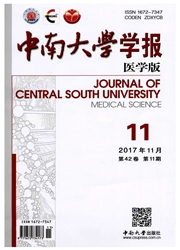

 中文摘要:
中文摘要:
目的:筛选临产活跃期子宫体部平滑肌差异基因表达谱,为子宫收缩相关药物靶点的选择提供候选基因。方法:应用8064条人类全长基因的cDNA表达谱芯片,分别筛选自然临产前后、缩宫素诱导临产前后和自然临产子宫体部与下段平滑肌的差异基因表达谱;用RT-PCR技术验证电压依赖性钙离子通道-L(voltage dependent calcium channel-L subtype,CACNA)的表达。通过生物信息学技术筛选具有药物靶点结构和功能的差异表达基因,作为子宫收缩相关药物候选的靶点。结果:在自然临产前后、缩宫素诱导临产前后及自然临产后体部与下段的子宫平滑肌中,筛选出29条显著上调的基因。CACNA基因表达在RT-PCR与芯片实验中结果一致。在显著上调的29条基因中,神经调节素B受体(neuromedin B receptor,NMBR)基因和神经肽Y(neupeptide Y,NPY)基因是具有宫缩相关药物靶点结构和功能的2种基因。在上述3种对比状态的子宫平滑肌细胞中,NMBR和NPY差异表达的比值分别为6.9,11.3,9.0和6.0,29.8,2.9。结论:不同临产状态的子宫平滑肌细胞共同表达上调的NMBR,可能是理想的、子宫收缩相关药物的候选靶点。
 英文摘要:
英文摘要:
Objective To screen the differentially expressed gene profile from the smooth muscles in the fundus uterus at the active stage of labor, and to provide candidate genes for picking out the drug targets related to uterine contraction. Methods Differentially expressed genes of uterine smooth muscles in the corpus from pro and post spontaneous parturition and those induced by oxytocin, as well as those from the corpus and the lower portion spontaneous parturition, were scanned respectively by human full-length genetic cDNA microarray with 8064 probe sets. Semi-quantitative RT-PCR was applied to testify the expression of voltage dependent calcium channel-L subtype ( CACNA ). The differentially expressed genes in the structure and function of the drug targets were picked out by bio-informatics to serve as candidate drug targets related to uterine contraction. Results The expressions of 29 genes were up-regulated in fundus smooth muscles from the pro and post natural parturition, the pro and post inductive parturition of oxytocin, and the natural parturition. The expression of CACNA gene in RT-PCR was in accordance with that in the microarray. Among the 29 genes, neuromedin B receptor (NMBR) gene and neupeptide Y (NPY) gene were the genes which not only had the targets of uterine contracted medicine, but also could contract the uterine. The differential expression ratios of NMBR in the above 3 types of uterine myometrium were 6.9,11.3, and 9.0, respectively ; while those of NPY were 6. 0,29. 8, and 2. 9 respectively. Conclusion NMBR, whose expression in the uterine smooth muscles is always up-regulated at different parturition conditions, is likely to be an ideal candidate target of uterotonic drugs.
 同期刊论文项目
同期刊论文项目
 同项目期刊论文
同项目期刊论文
 Neuromedin B and Its Receptor Induce Labor Onset and Are Associated with the RELA (NFKB P65)/IL6 Pat
Neuromedin B and Its Receptor Induce Labor Onset and Are Associated with the RELA (NFKB P65)/IL6 Pat 期刊信息
期刊信息
